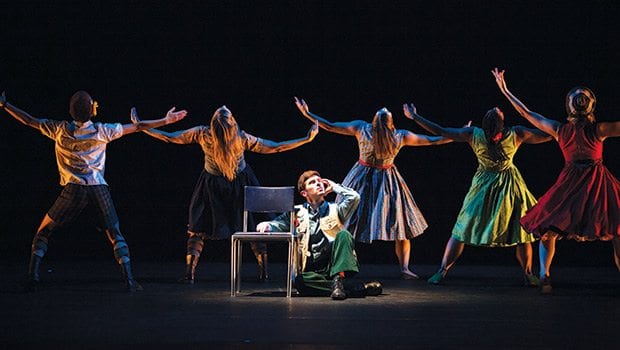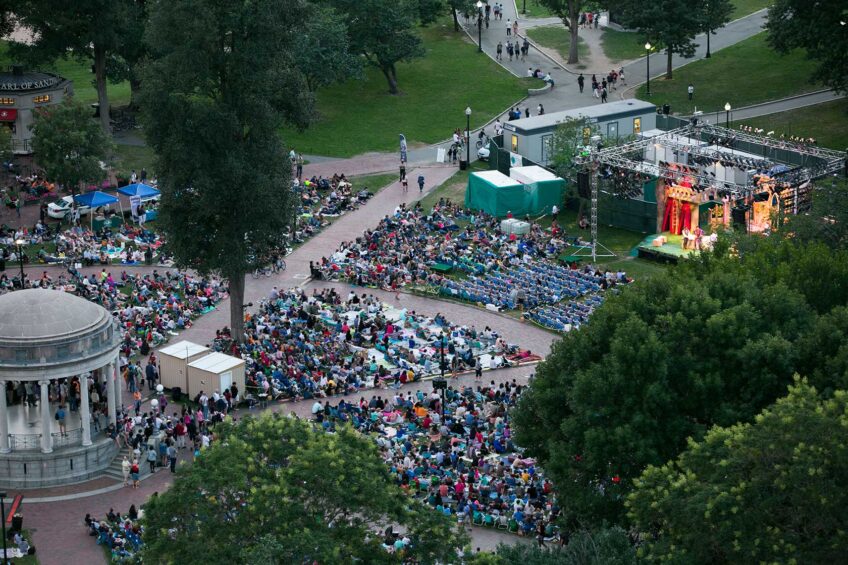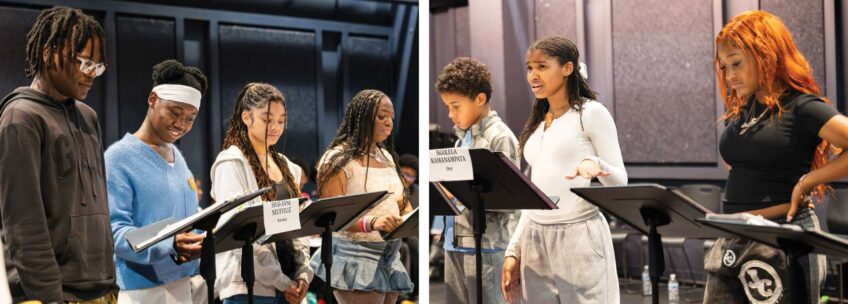
Since their start in the 1980s, choreographer Mark Morris and his company, the Mark Morris Dance Group, have performed often in Boston. Over the years, Morris has come to be regarded as the greatest choreographer of his time, but his Boston venues still include intimate concert halls as well as the city’s largest theaters. Last week, Morris and his company performed five nights in the intimate setting of the Institute of Contemporary Art’s 325-seat theater.
All of the qualities that have earned Morris his renown were on display in the program of four works: musicality, humor and above all, humanity, as well as a taste for mixing moments of surpassing beauty with a willingness to break the conventions of dance and create beauty from awkward, unexpected and visibly difficult moves.
The company performed with live music provided by its own musicians, pianist Colin Fowler and violinist Georgy Valtchev, who performed on stage.
The program opened with Italian Concerto, performed by five dancers as Colin Fowler played the music that inspired it: Bach’s Italian Concerto in F Major. The lighting, costumes and choreography shift with the tone and tempo of each movement in the composition.
The opening movement, Allegro, is a brightly lit scene that accents the orange and red costumes of the dancers, Lauren Grant and Aaron Loux, whose quick, playful dancing includes athletic gestures such as clenched fists.
The next movement, Andante, unfolds slowly on a darkened stage. Taking the role that Morris danced in the 2007 premier of the piece, Sam Black performed a solo wearing black body-fitting garb. He stretched, pulled and pushed his limbs as if the space surrounding him had weight, reflecting the contemplative mood of the music.
In the third movement, Presto, the tempo quickens and light returns as Rita Donahue and Brian Lawson execute a duo with baroque playfulness and athletic energy. All five dancers come together in the finale. Each performs his or her signature movements, but in unison, as members of an ensemble, embodying the harmony in the Bach composition.
Next, an ensemble of eight dancers performed A Wooden Tree, a suite of 14 short dances Morris created in 2012 to a recording by Scottish composer, singer, and humorist Ivor Cutler (1923-2006).
Cutler introduces himself as an oblique musical philosopher” and fan of old fashioned entertainment. He hand-pumps a harmonium to accompany his array of tunes, from a tribute to a loyal friend entitled Stick Out Your Chest to a playful nonsense rhyme, Cockadoodledon’t.
Morris responds to the oddity and droll humor of the songs with choreography to match.
Wearing outfits that could have come from a thrift shop — argyle socks, plaid pants, knit caps, sweater vests for the men and flared, girly dresses in bright colors for the women — the dancers appear to be having a ball as they execute frolicking but precise movements in tune with Cutler’s slightly surreal tales.
Somber tension
In contrast to this light-hearted romp, the program’s third piece is inspired by a somewhat somber classical composition, Suite for Violin and Piano, by pioneering American modernist composer Henry Cowell (1897-1965). Morris entitled the work Jenn and Spencer, for the two dancers who first performed it.
Violinist Valtchev and pianist Fowler accompanied Jenn Weddel and Brandon Randolph as their duo mined the composition’s tension, quicksilver tempo and riptides of passion. The violinist’s sustained lyrical flow provided a counterpoint to the pianist’s occasional descent into edgy chords and dissonant passages.
Both the music and dancing were intense, making the ebb and flow of human connection visible. Weddel, in a diaphanous, bare backed dress, and Randolph, wearing a dress shirt and body-fitting black pants, conveyed in their dancing the urgency and sensuousness of a newly intimate couple exploring and testing their relationship.
Circling each other, they begin with a demure, even courtly interplay, but as they interlock, they wind and unwind around each others’ limbs, mirror one another’s moves, and use hands, feet, legs and faces to connect with each other.
Echoing the fraught undertones of their connection, each gets a brief, peaceful solo free of dissonant piano chords. Weddel’s hair is long and loose like her dress, which becomes a prop as Randolph disappears within its folds. The two encircle each other like leaves spinning in the wind. Weddel falls back, demonstrating trust that Randolph will catch her, and he does.
Enchantment
Concluding the program was Words, a 2014 work for 18 dancers (17 performed it here) set to Songs Without Words, a series of short lyrical piano pieces by Romantic composer Felix Mendelssohn. Written between 1829 and 1845, the enchanting compositions became popular right away because they appealed to master pianists but were also within the reach of amateur musicians.
Morris echoes these qualities in the choreography, using a seemingly simple set of movements in endlessly inventive combinations that paralleled the phrases of the music.
As the pianist, Fowler, and violinist, Valtchev, performed the songs, the dancers’ movements flowed in synch with the music, which varied from a Venetian gondolier’s song to a folk melody.
Outfitted in V-neck T-shirts and shorts in a rainbow of warm colors from pink to scarlet, the dancers executed countless variations of basic dance phrases. Marking the transitions between one song and another, two dancers came out bearing a portable screen, behind which dancers would change places, some moving to the sidelines as others stepped forward to begin a new song.
In the intimate setting of the ICA’s black-box concert hall, Morris and his dancers conjured a world of enchantment.






